Atari’s massive success in the late 70s presented many challenges, not least of which was one of logistics: How were they going to get arcade product shipped globally to meet the huge demand for its arcade games? Transporting bulky 300lb lumps of wood, glass and metal around the globe from a single operational base in the USA was (and still is) an expensive business. Expecting European arcade operators to soak up that additional cost would have been commercial suicide. Add that to the fact that its main production plant in Sunnyvale California was already close to capacity meeting the demand in the USA, it was clear that Atari had to do something to take advantage of what was fast becoming a global market for its coin operated products.
As it happens, Atari had a European presence as early as 1974. In September of that year, Atari acquired a 50% stake in French company, Socodimex. With this money, Socodimex bought a shut-down manufacturing facility based in Baumes-les-Dames, from the French government. Under the name Atari Europe, jukeboxes and Atari video games were produced by Socodimex under licence from Atari, and distributed to several European countries. Similar arrangements were in place elsewhere – Lowen Automaten in Germany for example was another. I believe this arrangement was in place until Atari figured that it would make more sense commercially, for them to service Europe themselves.
So in 1978 Atari started looking at a number of locations in Europe that could act as a single base of manufacturing and distribution. A variety of possible solutions were considered, but rather bizarrely, a small Irish town called Tipperary quickly became the obvious choice. A new factory building had just been built on the outskirts of the town, and the Irish government (in the form of the Irish Development Authority), keen to attract overseas investment in the struggling town, successfully courted Atari with some very lucrative subsidies, grants and incentives.
Ireland offered excellent tax breaks to manufacturers setting up plants on their shores, and as a member of the EEC (now known as the EU), exporting product to other European countries was in theory a slick process.

Atari would eventually purchase this building from the Irish Authorities. Furthermore, two companies that could act as a subcontractor to assist with the logistics of building arcade cabinets were identified: Murray Kitchens, an established wooden cabinet builder, was within spitting distance of the main factory just down the road in the small town of Ardfinnan; and an hour’s drive away, Kromberg & Schubert, an electronic components company based in the coastal town of Waterford was secured under contract to supply the wiring harnesses, switches and bulb assemblies required for the Tipperary-built arcade machines. Despite being just a one-room factory built from breeze blocks, Kromberg & Schubert had a great German engineering pedigree, having supplied European car manufacturers with wiring looms for many years.
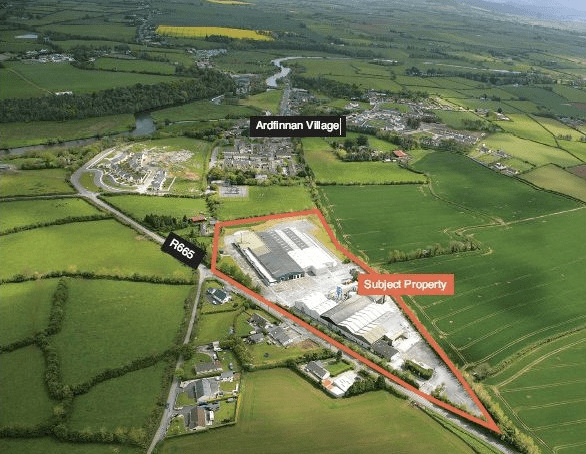
On paper it looked to be a perfect solution. All Atari had to do was produce game PCBs in California, and ship them to Ireland ready to install into the locally produced arcade carcasses. Atari’s new Californian PCB plant was huge, so the required capacity could be met quite easily – it was simply a case of extending the normal run already in place for the USA market. Sourcing wood, sheet metal, components and parts from local suppliers simply made commercial sense, and would extend the economic chain further. One suspects also, that this ‘local supplier’ logistics solution was a requirement of the Government subsidy deal, as this would secure much-needed employment to the residents of this rural area of Ireland.
Irish officials were very keen to help Atari get things up and running quickly, and within months of an agreement being signed, Atari started its Tipperary manufacturing operations in 1978. But there were teething problems. Atari’s employees arrived from the US with various tools to get started, including a fax machine – one of the first to be used on Irish shores, but quickly discovered that Tipperary’s phone exchange was as yet unable to handle international direct dialling. (Not surprisingly this oversight was quickly put right by the Irish Development Authority).
Further issues were identified at the cabinet building operation. Murray Kitchens were struggling with their new brief from their American taskmasters. The transformation for the Ardfinnan based company from making kitchen cabinets to Atari arcade cabinets was proving difficult. Despite being housed in a 30,000 square foot factory, they were only managing to produce around 20 of these new fangled Atari cabinets each day, still trying to get to grips with the change (and probably still hanging onto a lackadaisical 70s workforce ethic). Atari’s expectations were that they should be producing five times that amount – the daily target was in fact 125 cabinets. Things weren’t going well.

I’ve told this story before here on the blog, but it’s worth repeating here: Sensing trouble, the Vice President of Atari USA sent a task force across the Atlantic to sort things out. James Riordan was the head of the team flown over, and describes what happened:
When we arrived at the plant, fresh off the plane, I was greeted by a room full of local engineers who, before even introducing themselves, asked sarcastically, “What makes you think you can do this any better than we can?”. I replied, “Because gentlemen, I am making 500 arcade machines a day in the United States and my boss told me to either make this place perform or turn it into a badminton court, so I expect you to either work with me, or I can go buy you all some racquets and I’ll be on the next plane back”. Let’s just say they had an immediate change of attitude.
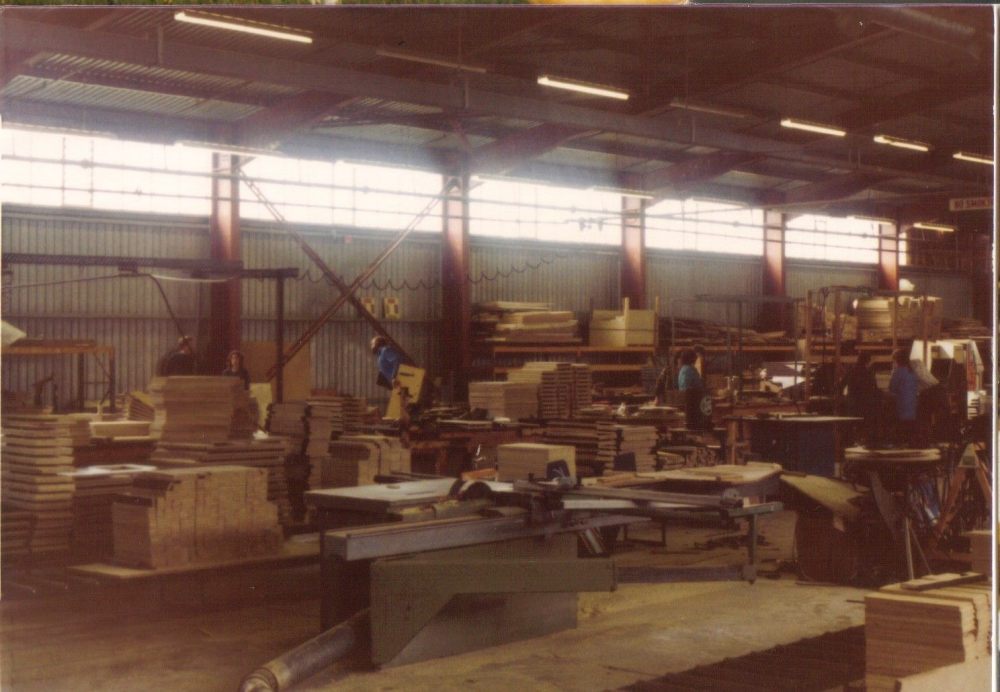
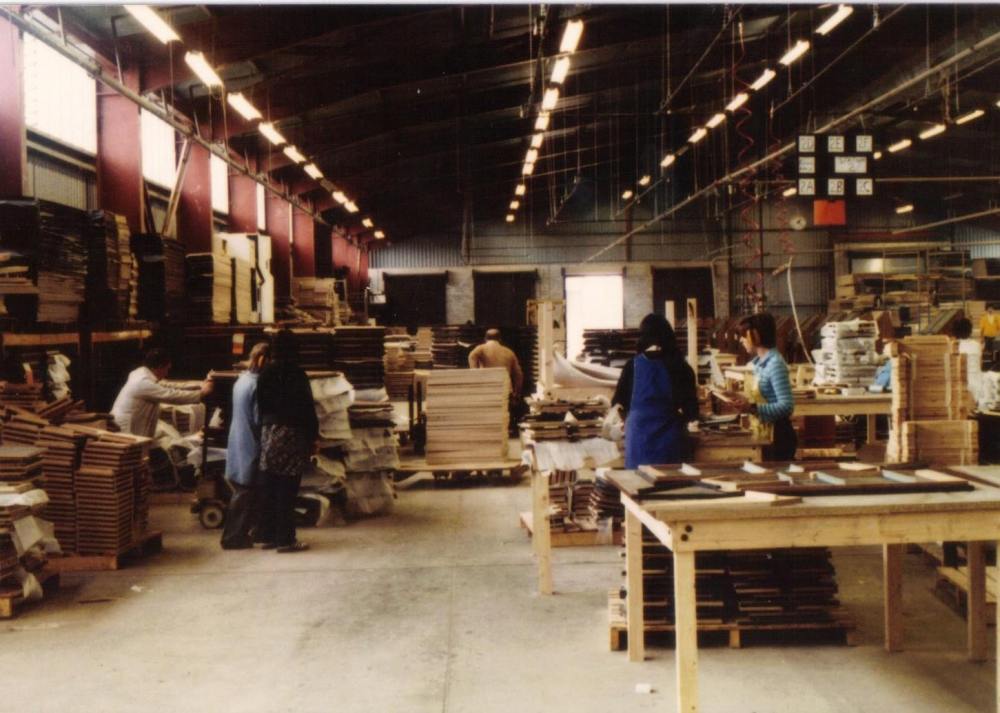
And so with that rather awkward start, the team built new production lines, streamlined systems, and retrained staff. Within eight weeks, Riordan had this Irish factory churning out on average, 151 Atari cabinets every day ready for distribution across the European markets. Well over the expected target. The staff were motivated and worked hard. This small increase in expected daily production of just 26 cabinets, added $1 million of earnings to Atari’s bottom line every single month.
You can see that this was big business for Atari, and for several years, tens of thousands arcade cabinets were built at Tipperary and shipped throughout Europe and beyond in large shipping containers, using an export company called Bell via the port of Waterford, just south of the town.
Whilst they aren’t the best quality, Atari’s January 1981 edition of Coin Connection magazine (produced to keep operators up to date with the latest Atari business news), featured a couple of images showing off its then new European facility:
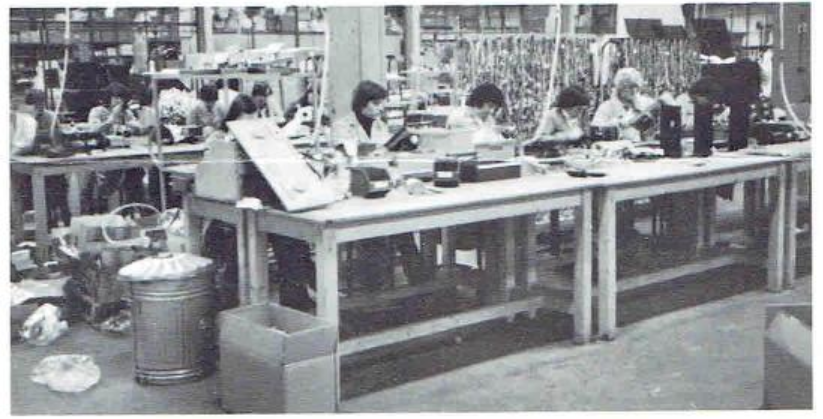

With so much at stake, Atari flew some of its best men over the Atlantic to oversee and run the operation as it grew. Gil Williams, a long-standing employee was placed in charge of the plant from 1979, along with Tommy Martinez and Phillip Stewart. All were American natives who brought a little bit of the California lifestyle to rural Ireland. The rest of the staff were all locals, including Kevin Hayes of Donegal, brought in as Financial Controller. Following Gil’s return to California in 1979, Kevin took over as Managing Director of the plant.

In time, production became slicker. Armed with each new cabinet plan from America, the factory at Ardfinnan would build the wooden cabinets. These shells would be moved to the main plant at Tipperary to be fashioned into the final product.
Former Atari employees recall a weekly container that would arrive by air every Friday direct from California. Within the shipment would be early build samples of prototype cabinets, parts, tools, printed circuit boards, schematics and plans, all with the intention of giving the Irish facility a guide to what they should be producing.

These three never seen before pictures from 1981, show rows of Asteroids Deluxe upright cabinets nearing completion at the Tipperary plant:
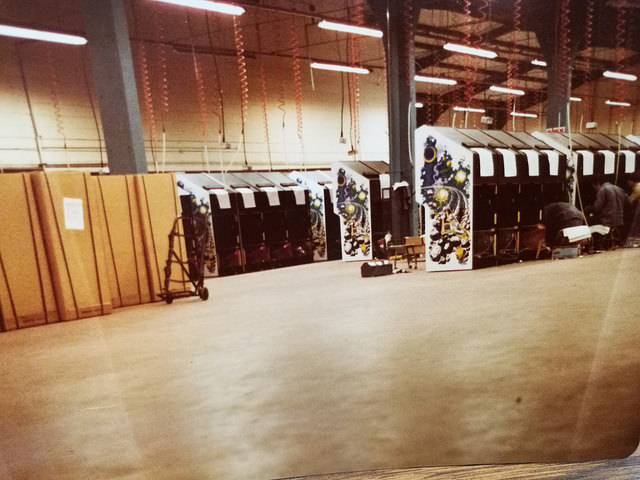
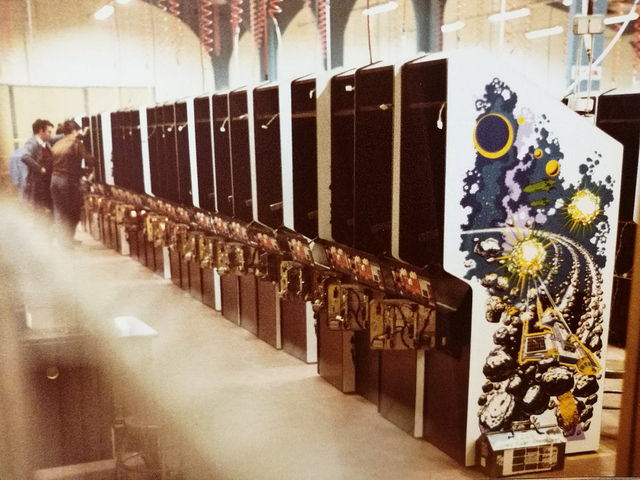

At its height, over 200 Irish workers were building 2,000 arcade cabinets a month ready to ship across Europe and beyond. Every major Atari arcade title was built here.
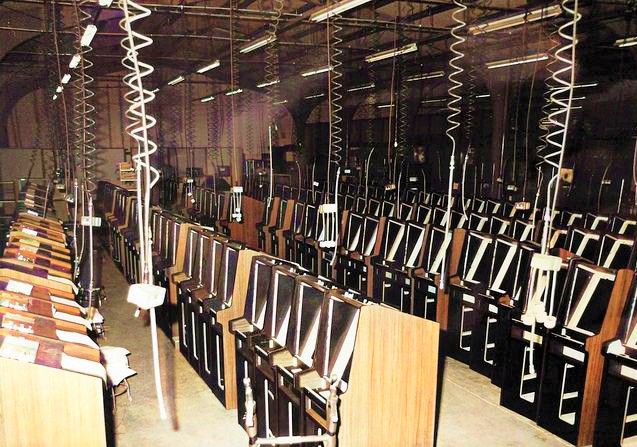
Here’s a cool thing that hasn’t been shared before. This T-Shirt dates back to 1980/1981 and was designed by George Opperman’s art team at Atari California and given to employees of Atari Ireland at a summer party at the local Aherlow House Hotel. Thanks to Atari collector Brett Gubitosi, who kindly shared these images of the shirt from his personal archive:
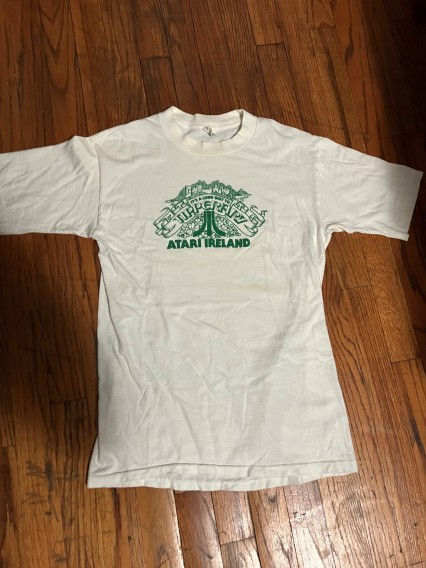
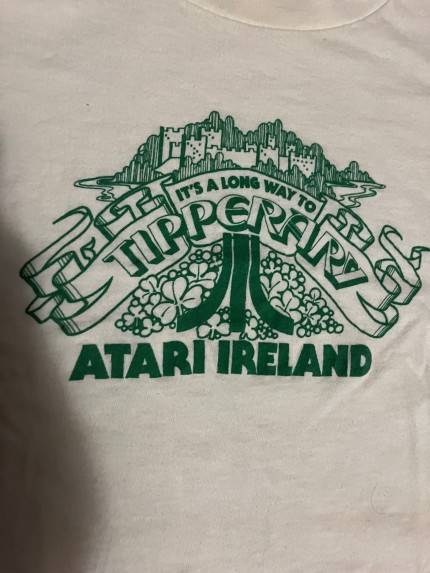
I personally own an Asteroids cabaret, Centipede cabaret, Battlezone cabaret and Tempest cabaret, all built at Tipperary. Although just a tiny fraction of the tens of thousands of cabinets that would have passed through the town during its heyday, it’s great to know that some of the cabinets pictured in these photos are still around to this day, safely in collectors’ hands across the world.

The cabinets produced at Tipperary and those pictured here will be familiar to US-based arcade collectors. The plans largely mirrored the designs pushed out by Atari in the American market. But interestingly, there were one or two cabinets that were unique to Atari Europe.
This cabinet design would house Atari’s European versions of Time Pilot, Food Fight, Millipede and Popeye games:

And this funky looking mid-sized cabinet was produced to house the Irish-built versions of Gravitar, Dig-Dug, Fast Freddie, Black Widow and Kangaroo:
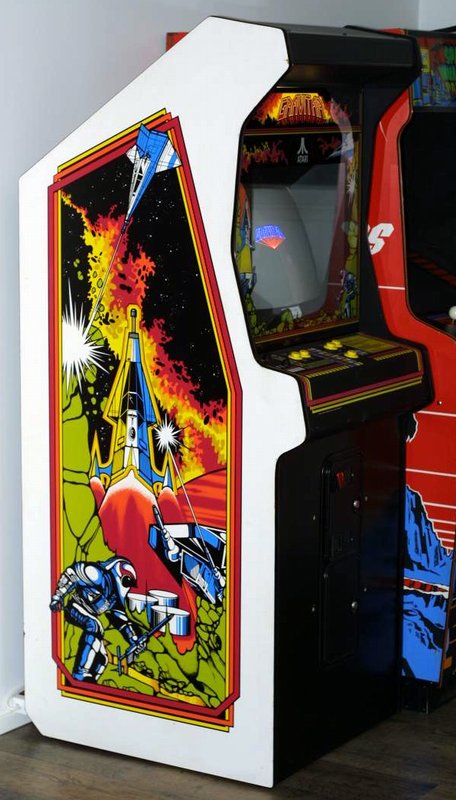
Some of these European-exclusive cabinets have popped up in the US – the concensus of opinion here is that Tipperary was known to have shipped cabinets to Canada as well as Europe (weird!). Exactly why these particular two cabinet designs veered away from their equivalent US-style designs is a mystery.


So operations continued until 1984, when the global demand for arcade cabinets slowed significantly. What followed was a patchwork of ownership: during that year, Japanese manufacturer Namco looking for a similar European based arrangement set up a five-year joint partnership with Atari. This proved commercially successful and added stability and security to the local workforce. Kevin left the firm at this time, and Namco brought their own man in to head thngs up; another local, Mike Nevin. In 1990, ownership went back to Atari, until being sold to Midway lock stock and barrel in 1995 for a short period of time. Namco then bought the facility alone, and the plant was run and managed by Pat Pickham a local Tipperary man until its eventual closure in 1998, with the loss of the its final 42 employees. One could imagine this was quite a blow to the local economy.

The closure of the Tipperary factory and its impact on the local area was discussed in the Irish parliament. You can read the transcript of that debate here.
Tipperary’s historical association with Atari remains strong to this day. Many local people would have worked at the plant, and for us European collectors, the arcade machines built there still turn up to this day. No question it was a key part of Atari’s growth and dominance in the arcade market during the Golden Age of arcade gaming.
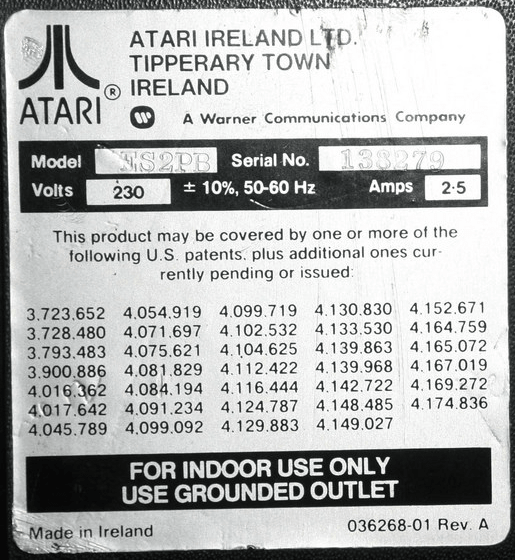
A company called MOY Insulation who occupied a neighbouring building for many years, took over the old Ardfinnan facility in 1998 until its demise in 2008. The buildings are still standing idle waiting for new businesses to arrive with investment for the local economy.
The main factory building in Tipperary is still there. The NAMCO sign is still present:

So there you have it. This small county in rural Ireland played host to one of the largest companies in the world, and produced huge numbers of arcade cabinets that were supplied across Europe. Atari Tipperary clearly played a key part in arcade history. Cool stuff.
Update: Had a message from a Tipperary local this month (September 2023) who took this picture of the site this morning:

Apparently the site was sold off by the local authority and is used for storage now. But cool to see the Namco sign still intact!
Huge thanks to Jim Riordan, Mike Jang (again!), the good folk at The Strong Museum in Rochester, NY and Alan from the Ardfinnan History Facebook Page – all generously provided additional insight into this subject, and allowed me to share these great pictures here on the blog.
If anyone has additional pictures, info or corrections they’d like me to add to this article, do get in touch using the About/Contact link at the top of this page and I’ll get back to you.
Many thanks for your visit this week. I’d appreciate your help in sharing this article using the social media buttons below.
Tony

My Star Wars cabinet was built here, still has the sticker on the back proclaiming its Tiperrary birthplace. Great article Tony!
LikeLiked by 2 people
AFAIK Sega also used Atari to build cabinets for them in the mid 80’s from this plant. I presume the partial looms that joined to the Sega loom were also made at the same place down the road as they are very Atari esq.
LikeLiked by 1 person
Great blog post, thanks.
Was nearby recently as decided to go see the building. Still has its Namco sign alright, was tempted to ask the current users for it. It really is off the beaten track in Ireland, strange location for it.
LikeLiked by 1 person
Such an amazing insight to something that has escaped me for years within Atari lineage while based here in Ireland, I do how ever remember traveling with my father to Atari’s Home Computer and console division up in Dublin south in the town of Tallaght to which my father having a great contact at Atari’s sales rep (Dominic Farrell) which brought the future of Atari to the home with amazing Atari VCS releases and a selection of Atari 8bit home software to a kid now in my 40’s lol that still celebrates all things Atari. So maybe you will that story if you manage to source those that worked there, it was an amazing place to visit at the age of 8 🙂
Kind regards.
LikeLiked by 1 person
Congratulations for this valuable source of a significant piece of Atari’s history. Amazing article!
I would also specially thank you, for giving me the permission to publish the Greek translation on “iamretro.gr”. I frankly believe that many Greek readers will definitely, find it very interesting. I’ll bet on it! 🙂
Best Regards
George
LikeLiked by 1 person
Fantastic article… you brought me back in time theee! Growing up across from this building it provided a playground for the local kids, but as we grew up we understood the significance this building had for the town and it’s working people. Thanks Colm
LikeLiked by 1 person
Another great story Tony. Love Atari everything, so can never get enough of these stories and photos. What a great time to be an Irish woodworker!! I always chuckle when I read the badminton court speech, too. Thanks for sharing pal.
LikeLiked by 1 person
Tony – excellent article, I just read it today. If you are interested I can supply you with some corrections / amplifications / somewhat different spin on this subject. I am particularly strong on the 1978/84 period and can put you in touch with Mike Nevin and Pat Pickham to flesh out the 1984 – 1998 timeline.
LikeLiked by 1 person
Kevin did a great job painting some of the atmosphere of Atari Ireland wen I talked with him. There’s also a few more photos, though low quality, in Atari Coin Connection.
LikeLiked by 1 person
Great pictures, thanks!
Sorry to nitpick but those “power cords” hanging down are actually air hoses to power pneumatic (air powered) staplers, not hydraulic (fluid powered) tools.
LikeLike
Hi Tony, great job on the story. We had a lot of fun over there!! Noah Anglin and VP Steve Bristow let me take along my wife Lynn and our young son Brett. Atari kindly paid all expenses. Lynn handled communications and helped me the whole time as well. She was already working with me in our company, Overnight Engineering, Inc, which became The Riordan company , or http://www.Riordanco.com. It was great fun for me to help set up the facility, since some of my ancestors came from County Tipp! We taught a lot of the locals about real production , and went through 3 rent-a-cars or ” Self-drives” roaring around the countryside . ( We were a little … .ummm . or a LOT, hard on them ) It was fun being a “crazy Irishman” in Ireland!!. Heard , “Oh, Riordan it tis” a lot from the locals And I am happy to report that the facilities remained productive well after we set them up and left. I had many, many fun times at Atari with a lot of great folks , some of whom I still remain in contact with today in 2019!
LikeLiked by 1 person
Thanks for checking in here Jim! Appreciate you sharing the stories sir!
LikeLike
Hi Tony
I had the misfortune of purchasing a Badlands kit in the early 90’s that developed a board fault . However as luck would have it Berry Kane Atari California arranged for me to travel from Clara down to the plant in Tipperary where I was met by Mike Nevin and others whom exchanged my faulty pcb for a replacement Badlands pcb marked as a “working prototype” which I still have in my possession to this day.
Thats my 2 cents worth
Aidan
LikeLike
I wonder if anyone knows the actual build numbers of each cabinet and cocktail.
It would be interesting if there was a list of serial numbers, to see if my cocktail Asteroids was one of the last.
(CAS 80752)
I’m guessing that’s
(C)ocktail (AS)teroids 80752
LikeLiked by 1 person
Hey. Yes you’ll probably find yours is number 752. But Atari had a habit of doing weird things with serial numbers. I’m not sure how Irish cabs serial numbers might have related to US serial numbers, but it’s fair to say less were probably produced at Ireland than in the US. According to records 8725 cocktails were produced, but I suspect those are US numbers – but maybe US and EU combined.
LikeLike
I doubt very much if that information is available anywhere. Glad to hear yours is still alive. And well?
Kevin Hayes
MD of Atari Ireland Ltd. when they were made.
LikeLiked by 1 person
Oh, yes, mine is in excellent condition. I bought 2 of them about 35 years ago from a guy who had about 5 in his kitchen. (He was an arcade operator) We managed to get them both in the back of a Talbot alpine with the back seats folded down (small car)
It developed a minor fault where half the screen didn’t display, but my basic knowledge of electronics at the time I worked it out to be a bit of dirt on the tracks of the pots that adjust the screen size. Fixed it in seconds!
Recently, I moved it 130 miles across the country from my late mother’s house where it had sat idle for 25 years. Now, it has a slight fault where the saucers don’t make the high or low pitched warble when they are on screen. I thought it was the 555 chip but I think it may be the other one (was it the 566?)
Amyway, it works perfectly apart from that minor sound issue.
LikeLiked by 1 person
Tony I love this artcile. i read it a while ago and i forgot about it till tonight. i met a guy online who is making a movie of arcade history and i shared this with him. heres his trailer. https://arcadedocumentary.com/ i grew up in Barneys/Playland etc in Dublin. Sapce invaders was and always will be the king
LikeLiked by 2 people
Fantastic article.
I found out earlier today that my dad’s shipping company brought in cabs by the truckload from Atari Ireland in the 80s. The thought of all those interminable hours spent bored at his office when there was a warehouse full of some of the greatest arcade games of all-time just feet away is torture – if only I’d have known at the time!
LikeLiked by 1 person
Brilliant read.. my father worked in Tipperary company for years.. Brilliant memories of going to see santa and going on summer day trips with the Atari gang.. my father had many beautiful memories there.. its so cool to think my dad was a part in one biggest companies for arcades..
LikeLiked by 1 person
I worked in the Tipp plant in 1988 for 9 months as part of my coop education from the University of Limerick. And again the following summer. During that time the big hit game was a driving game called Final Lap. When the prototype arrived from Japan, there was a problem. One of the main connectors to the motherboard had the cabling soldered in place, as opposed to the standard “stamped” connection method. The plant was unionized at the time and nobody was qualified to do this kind of work. As a college student, I was not in the union, and I had done some of this type of thing before, so, I was pressed into service. I got tons of overtime, but it was tedious work, soldering 18 separate cables onto a 48 pin connector.
But after I graduated the following year, I went backpacking all around Europe. Final Lap was everywhere, and it was really cool to think that “I helped make that” whether I saw the game in France, Italy, Norway or wherever!
LikeLiked by 1 person
Great stuff – thanks for your comment Paul!
LikeLike
Good background story, Paul. Final Lap was a big hit for Namco/Atari.
LikeLiked by 1 person
I worked there for 12 years from 1983 was only 15 when I started. Brilliant memories great story.
LikeLike
And out of that tiny town and plant came a marriage, seven children and raising them in sunny California. They are all grown now, three still live in California and the four others are in Texas, Georgia and London. Two of those seven are engineers. Just like their dad.
Atari truly was a huge piece of my family’s history. My (now ex) husband was the first Irish employee at the Atari plant in 1978 and continued his employment in California until 1994.
LikeLike
Actually my ex husband was employed by atari until 1996. And I remember those Americans very well. Lyle Raines, Dan van Elderen, Carol Massey, Stevie Landaverdi are a few of the others who visited.
Phil Stewart made quite the impact in Tipperary too.
LikeLike